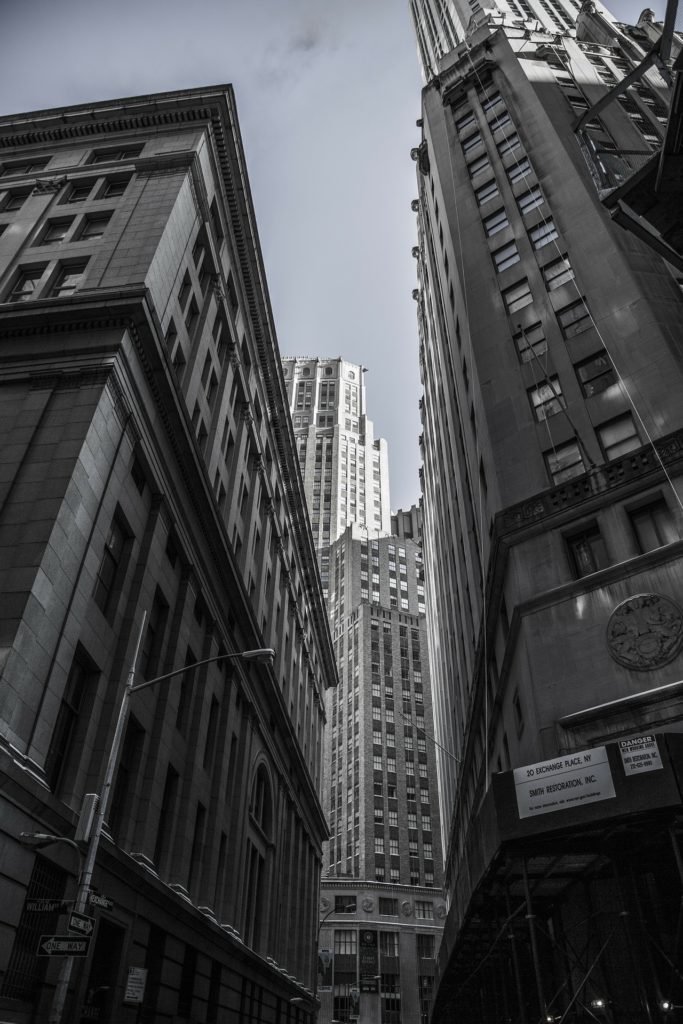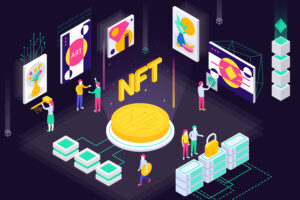
Someone has put a giant inflatable rat outside the Federal Reserve Bank in New York.
It’s covered in Bitcoin code, printed in rainbow colors, and is apparently a piece of installation art aimed at subverting the federal institution that controls the US dollar. Or is it pale, puffed-up pariah a commentary on Bitcoin bros themselves? Or does it have something to do with Warren Buffett, who earlier this year called Bitcoin “rat poison squared”? According to CoinDesk, who first reported on the inflatable rat, the meaning is intentionally ambiguous.
The artist behind the puzzling prank is Nelson Saiers. He describes his own work as “mystifying” and “singularly original”, notwithstanding the long history of rats being inflated as protests or used as economic and political icons in art and entertainment around the world.
“It’s art, so I hope they’re entertained by it,” he said, apparently implying that art is entertainment. “It’s informative, I hope people will learn [and] I’m hoping it’ll at least help people understand bitcoin better and be kind of faithful to what Satoshi would have wanted,” he added, citing the mysterious pseudonym of Bitcoin’s founder with a touch of reverence.
A $50 Million Artist
Saiers, a phD in theoretical mathematics, was a hedge fund manager who did that thing where you give up all the money to chase your dream of being an artist.
His financial experience includes a stint as managing director at Deutsche Bank’s prop trading desk, before becoming CIO of Saiers Capital, the hedge fund that bears his name. His creative career gives credence to the theory that working as an artist is more and more a privilege of the very wealthy.
CNBC estimated Saiers’s wealth to be around $50 million at the time of he departed from the financial industry to pick up his paintbrushes.
The Rat Joins a Tradition of Sculpture-as-Commentary in FiDi
The Bitcoin rat, which stands on Maiden Lane, isn’t the first pop up sculpture to grace Manhattan’s financial district. Last year, Kristen Visbal’s 50 inch bronze ‘Fearless Girl’ statue made waves by staring down the famous ‘Charging Bull’, to the outrage of ‘Charging Bull’ sculptor Arturo Di Modica. The 3.5 ton ‘Charging Bull’ itself was left on Wall Street in the middle of the night when Di Modica originally created it, obstructing traffic and drawing the curiosity of passers by.
When Saiers placed the Bitcoin rat, he initially set it up on private property and was promptly ushered off by security guards, who he says were good natured about the situation. He expects the sculpture to be more temporary than the aforementioned Wall Street bronzes, and will probably only be around for a few days.
A Critique of the 2008 Bailouts
The placement of the rat on Maiden Lane seems to be no accident, but rather a reference to the Maiden Lane Transactions, more commonly known as that time when the Fed bailed out the big banks after they all caused the 2008 market crash. The Bitcoin crowd’s antipathy towards the Fed and the big banks is palpable in Sairs’s rat sculpture, and while a more specific meaning eludes, perhaps the success of the piece depends upon its ability to start conversations about the state of finance.
We’ll leave it to the viewers to decide who’s the rat—the Federal Reserve, or Bitcoin itself—and what that means for the future of currencies.
















Great information. Lucky me I recently found your blog by
accident (stumbleupon). I have bookmarked it for later!
http://drugstoresydik.com/ buy cialis online cheap
http://canadianpharmacyonlinesrvh.com/ modafinil online pharmacy
http://onlinepharmacycanadasctu.com/ walgreens online pharmacy
http://pharmacystorefvnh.com/ best place to buy cialis online forum
http://drugstorepharmacyxerh.com/ buy generic cialis online
http://erectiledysfunctionnfsc.com/ viagra online canadian pharmacy
http://canadadrugsonlinergla.com/ my canadian pharmacy
http://onlinepharmacybvyk.com/ buying drugs from canada
http://canadaonlinepharmacyhtik.com/ buy cialis online reddit
http://canadadrugsrwdi.com/ is there a generic viagra
http://canadadrugpharmacywhik.com/ canada drugs coupon code
http://canadianonlinepharmacyrgby.com/ canadian pharmacy review
viagra need prescription buy viagra best herbal viagra
Noulse discount for custom writing http://www.buyessayxus.com/ – pay to write essay
Viackkiz how much viagra should i take for the first time http://www.viagrakr.com/ – buy viagra dana adams viagra Noulse
buy tadalafil india tadacip buy cheap cialis cost buy cialis online
grant writing service essay writing service online will writing service uk
generic viagra online
Oneste cialis online pharmacy http://cialisnorxs.com/ – cialis online canada cialis generic sudden hearing loss Estarne
buy essay online
http://buyviagricxr.com/ prescription drugs online
http://canadabuyeds.com/ buy cialis online cheap
http://gogogeneric.com/ canadian pharmacies
http://cheapgogenvia.com/ where to buy cialis
http://buyviagenonline.com/ viagra generic
http://onlineviagenfox.com/ canada drugs review
tadalafil – http://cialiaswiskmetri.com
buy cialis – http://cialiaswiskmetri.com
cialis online – http://cialiaswiskmetri.com
generic cialis – http://cialiaswiskmetri.com
buy generic cialis – http://cialiaswiskmetri.com
cialis price – http://cialiaswiskmetri.com
cialis 20mg – http://cialiaswiskmetri.com
cialis canada – http://cialiaswiskmetri.com
cialis – http://cialiaswiskmetri.com
cialis coupon – http://cialiaswiskmetri.com
cheap cialis – http://cialiaswiskmetri.com
buy cialis online – http://cialiaswiskmetri.com
generic cialis online – http://cialiaswiskmetri.com
foxwoods online casino online casino games
zone online casino zone online casino
san manuel online casino kraina-zabawek.com
borgata online casino borgata online casino
online casino games caesars online casino
caesars online casino kraina-zabawek.com
zone online casino olg online casino
tropicana online casino best online casino
golden nugget online casino zone online casino
best online casino zone online casino
golden nugget online casino best online casino
olg online casino zone online casino
resorts online casino tropicana online casino
tropicana online casino golden nugget online casino
golden nugget online casino caesars online casino
olg online casino tropicana online casino
borgata online casino http://www.kraina-zabawek.com
casino online online casino games
san manuel online casino resorts online casino
golden nugget online casino golden nugget online casino
golden nugget online casino kraina-zabawek.com
zone online casino kraina-zabawek.com
casino online foxwoods online casino
tropicana online casino san manuel online casino
casino online borgata online casino
borgata online casino caesars online casino
golden nugget online casino casino online
san manuel online casino foxwoods online casino
tropicana online casino http://www.kraina-zabawek.com
online casino games foxwoods online casino
san manuel online casino san manuel online casino
online casino games online casinos
Your style is so unique in comparison to other folks I have read stuff from. Thank you for posting when you have the opportunity, Guess I’ll just bookmark this blog.
online casinos online casinos
best online casino kraina-zabawek.com
most reliable canadian pharmacies
canadian pharmary without prescription
legitimate canadian mail order pharmacies
canadian online pharmacy
online pharmacy
canadian pharmacy
overseas pharmacies that deliver to usa
mexican pharmacies shipping to usa
canadian online pharmacies
It’s actually a great and helpful piece of information. I am satisfied that you
shared this useful info with us. Please keep us informed like this.
Thanks for sharing.
rx online no prior prescription
Hi there, I log on to your new stuff regularly. Your writing style is witty, keep up the good work!
online pharmacy
I am now not certain the place you are getting your information, however great topic.
I must spend a while learning much more or working out more.
Thanks for magnificent info I used to be searching for this information for my mission.
Hello There. I discovered your weblog using msn. That is a really neatly written article.
I’ll be sure to bookmark it and return to learn extra of your useful info.
Thanks for the post. I will definitely comeback.
I believe what you posted was actually very reasonable.
But, think about this, what if you were to create
a killer title? I am not suggesting your information isn’t solid., but suppose
you added a post title to possibly get people’s attention? I
mean There’s an Inflatable ‘Bitcoin Rat’ Staring Down the Fed – The
Block Talk is kinda boring. You might glance at Yahoo’s home page and note how they write news titles to
get viewers to click. You might add a related video or
a picture or two to get people excited about everything’ve written. Just my opinion, it could
bring your website a little livelier.
Hey folks,
I wanna buy keto pills to expedite whole process. I did some research but i’m not sure about it.
One of the sites i found is buyketopills.best
Any advice?
clomid alcohol https://clomidweb.com/
acetaminophen generic brands https://tylenol1st.com/
What’s up it’s me, I am also visiting this web site on a
regular basis, this site is truly good and the users are
genuinely sharing pleasant thoughts.